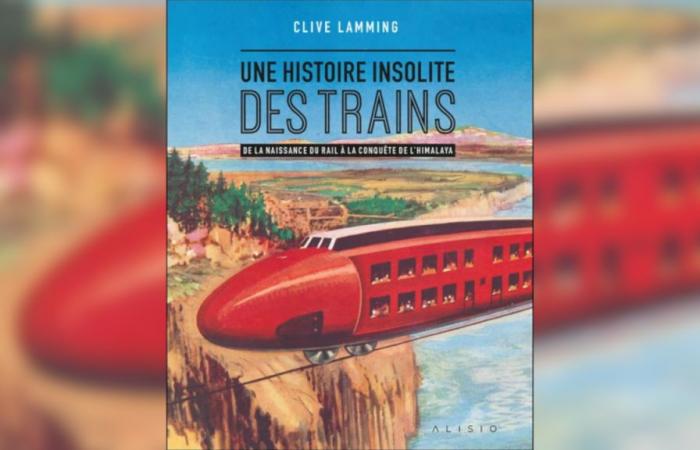Did you know that to build a TGV line, the high-speed train, you have to pay 20 million euros per kilometer? Did you know that in Africa, railways do not have the same gauge, which prevents transport between countries? Here are so many unusual questions and answers in the book of one of the greatest train connoisseurs in the world! It was also he, Clive Lamming, who was chosen to advise the filming of filmmaker Martin Scorsese! Clive Lamming publishes his new book this week: An unusual history of trainspublished by Alivio.
RFI: Your work is very original. Lots of pictures and stories! We discover the beginnings of railways in Africa. The origin, you say, is linked to European colonialism.
Clive Lamming : Yes. There France and the United Kingdom were the first to build in Africa. France, for the network in Algeria, Tunisia and Morocco. The United Kingdom, for Egypt and South Africa.
The origin of rail transport is linked to the need for supplies of raw materials and goods. The concern for passenger transport came much later!
Perfectly. In the beginning, coal, the main source of energy at the time (20th century) which was intended to be transported across a country or region, going to neighboring countries.
With one big problem… The gauge of the rails was standardized, common to the French colonies. But different from that of the countries equipped by the United Kingdom.
So trains cannot go from one country to another. The standard European gauge is 1.435 m. In Africa, if you want to travel from one country to another, with the few routes available, it’s impossible! You have to change trains or change the track gauge. This lack of harmonization increases the costs and travel time of convoys.
Today, you deplore the absence of modern railways across the continent.
It’s a shame, Africa is under-equipped with trains. Besides, like South America which lacks trains and networks. It’s not just a political or economic problem, I must say that mountainous countries, where regions remain sparsely populated and high up, do not facilitate construction.
Now, with one difference… Are you telling us that in Africa, there was a rail network project across the entire continent?
It was the African Railway Union! It was about connecting south to north and east to west. This project comes up from time to time in African conferences! But I fear that with the wars and current violence, it is doomed to failure.
The Chinese have equipped Greece with the gauges standardized in Europe (1,453 m). Did they do the same thing in the African countries they equipped?
Yes ! The two most important examples are Ethiopia and Sierra Leone. China has built traditional railways with conventional trains. And it works very well!
The Chinese are known for their “entryism” in terms of transport on under-equipped continents. We see it for the construction of ports, roads or airports. Is it the same for the train?
Yes. The majority of African countries do not have the money to build a railway network. Even in Europe, you know! A TGV line costs 20 million euros per km! The train is expensive and takes a very long time to build. Then there is regular maintenance and work on the tracks. The Chinese strategy is effective. They offer countries to build infrastructure for free in exchange for trade negotiations.
Yes, at the peril of countries falling into debt. Sometimes, they even regret it, because they can no longer pay the large sums!
Maybe, but when it works like Ethiopia or Sierra Leone, that’s a good thing.
This year, the new president of Peru called on China to come and build railways in her country. When you are asked about the future of trains in Latin America, or even in the USA, you say that you don’t really believe in it.
For a simple reason: too long distances! For non-perishable goods and raw materials, it’s worth it. But for people, flying has now become a habit. The train is profitable in small, densely populated countries. Japan and Switzerland! These are the train champion countries, it is said.
Your book is full of images! We go from archive photos to the most futuristic photos with chapters on models of trains or means of propulsion that remained at the drawing stage or fell into oblivion!
You know, I’ve spent my life passionate about and writing about trains. I am a historian. My job allows me to compare eras and see everything! From the most unusual train projects to the most demanding travelers! I dedicate an entire chapter to the trains of kings!
Finally, let’s open your chapter dedicated to railway professions. From the switchman to the driver, you offer us a beautiful gallery of photographs from all countries and all eras, once again! So, for the young RFI listeners who read you, what are the careers today for train enthusiasts?
All train jobs are great! Today, IT is changing professions. But the train, ultimately, remains quite classic. We will always need personnel to repair the tracks. The engineering profession is undoubtedly the most emblematic for the future. To operate the machines, humans will always be needed. I have trained many engineers and I see that today’s young women and men are passionate about inventing different models. Railway engineers have a bright future…
Also readAfrican trains: Tana-East Coast, umbilical cord of the Malagasy economy






